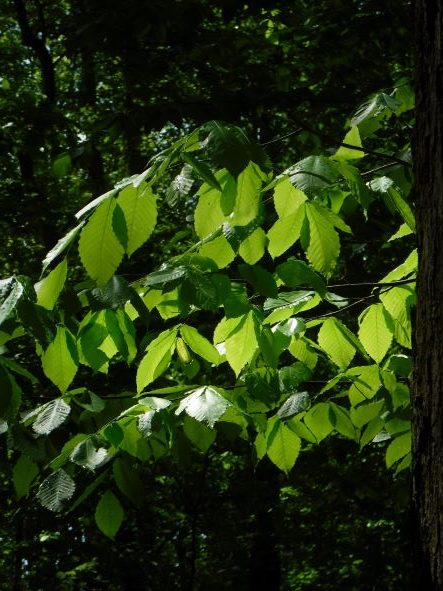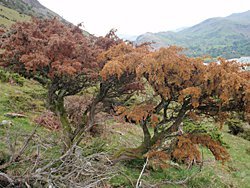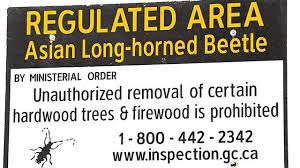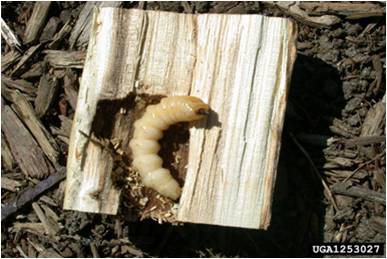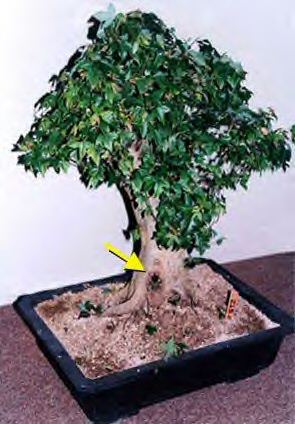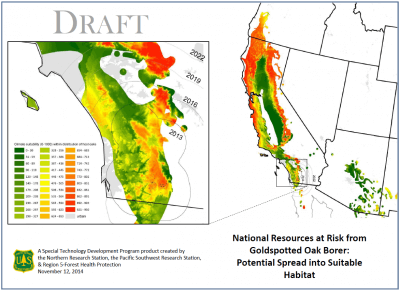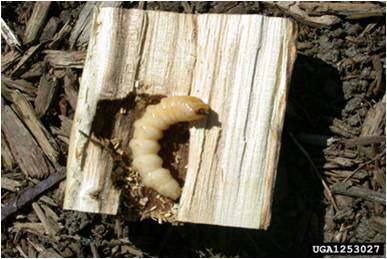American beech (Fagus grandifolia) is a widespread and beautiful tree of the eastern deciduous forest. Its range reaches from Nova Scotia to eastern Wisconsin, then south to Mississippi and Louisiana and east to mid-Georgia. It is an important food source for 40 wildlife species, particularly in the northern parts of its range where few other species produce hard mast. (See Lovett et al. 2006.)
Threats
Unfortunately American beech is under threat from three non-native organisms or complexes: 1) beech bark disease, 2) beech leaf disease, and 3) beech leaf mining weevil. A fourth pest, a previously unknown – and still unnamed bark beetle in the genus Agrilus – has been detected in New York City on European beech trees. It is not yet known whether it will attack American beech and, if so, whether it will also cause serious damage (Michael Bohne, USFS, pers. comm.)

Beech bark disease (BBD) results from the interaction of the introduced European beech scale insect (Cryptococcus fagisuga) and several fungi in the Neonectria genus – some of which are also introduced. The resulting disease has been killing American beech trees since the beginning of the 20th Century. It has spread from Nova Scotia to much of the tree’s range. It has dramatically altered the composition and structure of stands containing beech.

Beech leaf disease (BLD) was initially detected in 2012, near Cleveland. As of December, 2021, it has spread due east across New York, Pennsylvania, and New Jersey to the Atlantic, then up the coast through Connecticut and eastern Massachusetts, with a separate outbreak in central Maine. The disease is apparently associated with a nematode, Litylenchus crenatae ssp. mccanni, although additional pathogens, like bacteria, might also play a role. The origin of the North American population of the nematode is unknown; it is a related but separate subspecies from a Japanese nematode (Reed et al. 2022).

Beech leaf mining weevil (Orchestes fagi) is, so far, limited to Nova Scotia. However, it is expected that the weevil will continue spreading throughout the range of American beech through both natural dispersal and human-assisted movement. Repeated defoliation by the weevil might increases mortality rates in forests that are surviving in the “aftermath” stage of BBD (Sweeney et al. 2020).
A new study (Reed et al. 2022) concludes that, despite being detected only 10 years ago, BLD has already become pervasive in forests surrounding Lake Erie in the U.S. and Ontario. While somewhat more prevalent in U.S. states on the eastern side of the Great Lakes (on 54% of trees) than in Ontario (on 46% of trees), BLD is spreading rapidly and affecting every canopy layer. Mortality is highest in seedlings and saplings; understory saplings die within 2 – 5 years. The occasional mortality of overstory trees occurs within seven years of [observed] infection. Defoliation and mortality of saplings allow more light to pass through to the understory; this is expected to alter plant communities on the forest floor.
Beech scale is more widespread in Ontario (found on 60% of trees) than in the U.S. (38% of trees). This is not surprising since the scale was detected in Ontario in 1960, 24 years before it was detected in portions of Ohio, New York and Pennsylvania included in the study (in 1984). Throughout this region, beech scale is disproportionately affecting overstory trees.
Only 4% of trees throughout the study area are infected with Neonectria cankers. In other words, full-scale beech bark disease is not yet widespread and is spreading surprisingly slowly. Scientists do not understand this phenomenon.
These findings are based on a network of monitoring plots a network of monitoring plots set up in 2019 set up in areas surrounding the Great Lakes. They comprise 34 plots at 17 locations in southwest Ontario and 30 plots at 25 locations in Ohio, Pennsylvania, and New York. In total the plots hold 646 live American beech trees — 412 saplings; 85 in the intermediate/suppressed (subcanopy) category; and 149 in the dominant/codominant (canopy) class.
Forest composition is similar throughout the study area. The most common species in association with American beech are sugar and red maples (Acer spp.), and white and green ash (Fraxinus spp.). Other tree species present include eastern hemlock (Tsuga canadensis), white pine (Pinus strobus), oaks (Quercus spp.), and birches (Betula spp.). Study plots had few invasive plants – although the invasive species present are well-documented to invade forests.
Ontario disease assessment
In Ontario, BLD was identified in 25 of the 34 plots. It was present on 171 saplings, 53 intermediate trees, and 70 dominant trees. Both prevalence and severity were greatest on intermediate trees. Beech scale was present at all 34 plots. While scales were found on trees of all sizes, they were almost two times more prevalent and were more severe on mature trees than saplings. Neonectria cankers were detected at 34 plots. Neonectria was rare but most severe on dominant trees. Fewer than one third of saplings and one-sixth of mature trees were pest free.
U.S. disease assessment
BLD was present in 17 of the 30 plots. It was found on 75 saplings, 30 intermediate trees, and 38 dominant trees. Saplings and dominant trees had similar levels of disease; intermediate trees had significantly less. However, BLD severity was twice as high on saplings compared to mature trees. BLD was present on more than half of the seedlings assessed – 46 out of 82. Beech scale was present in 20 of the 30 plots. It was significantly less common and severe on saplings than on mature trees. Neonectria cankers were present in only 4 of 30 plots. Canker prevalence and severity did not differ significantly among size classes.
Distribution and Effects of Beech Scale and BBD
While beech scale attack facilitates invasion by the Neonectria fungi, the disease – BBD complex – had the most limited distribution of the three pests in this study. It was found on only ~4% of beech trees throughout the study area. The disease was first reported there in the early 2000s. Although no one knows why, it has spread more slowly there than in areas to the east (Reed et al. 2022).
As is the case with beech scale, BBD disproportionately affects large diameter trees. Typically, BBD kills more than half of mature beech within 10 years of its arrival. Dying trees produce prolific root sprouts resulting in dense beech sapling understories that impede regeneration of less shade-tolerant tree species. The persistence of thickets of disease-vulnerable small beech perpetuates the disease. BBD is the only forest disease in North America that can inadvertently intensify itself by increasing densities of its host while suppressing other species.
Beech Forest Community Change in Response to Combined Impacts of BBD and BLD
It is unclear how forests will change as beech die. Some expect saplings of species already present — red maple, white ash, and, especially sugar maple — to exploit the canopy gaps. Of course, white and green ash are under attack by the emerald ash borer; DMF their ability to reach the canopy will depend on the success of biocontrol agents.
However, if BBD or BLD resistant beech survive or if BLD fails to persist, future forests might instead consist of beech thickets that would prevent all but the most shade tolerant species from establishing. Heavy deer predation on maple seedlings and saplings might also play a role. A third possibility is that morbidity from BBD and BLD might lead to uneven-aged conditions that allow younger trees — perhaps even shade intolerant species e.g., oaks — to establish.
Invasive plants also have the potential to fill gaps left by declining beech. While maple-beech forests often have sparse understories due to low understory light levels, pest-caused canopy gaps are expected to increase the abundance of invaders, especially in small woodlots and forests near urban areas. Several shade-tolerant invasive shrubs are already present in low numbers: Japanese barberry (Berberis thunbergii), tatarian honeysuckle (Lonicera tatarica), multiflora rose (Rosa multiflora), and buckthorn (Frangula sp.). Reed et al. (2022) note that these species, plus privet and autumn olive, can take advantage of small canopy gaps, especially when soils are disturbed, e.g., by active intervention to counteract the loss of beech.
Precautionary Research and Management
Reed et al. (2022) call for enhanced monitoring of beech forests focused on
- the timing of BLD presence relative to tree age and size – which might affect competitiveness of sprouting beech in the understory; and
- compositional and structural change in forests with BLD or to which it is likely to spread
They also recommend abandoning the management approach for BBD currently recommended by foresters. It calls for removing scale-susceptible beech so that resistant genotypes increase in prevalence. In forests with both BBD and BLD, they conclude, management of natural regeneration is unlikely to succeed because BLD will kill sprouts and saplings that might be resistant to scale. They recommend instead active management of the forest to promote mast-producing, shade intolerant species, such as oaks and hickories.
They also recommend increased support for resistance-breeding programs. Such programs already target BBD, based on the estimated 1% of American beech that show some resistance. Now those programs need to incorporate BLD resistance. (Reed et al. note that small numbers of beech show few or no BLD symptoms so might possess resistance or tolerance.)

Unfortunately, the Canadian beech breeding program’s future funding is highly uncertain. To counter this threat, in part, Reed et al. (2022) suggest cryopreserving beech embryos from Canada to develop a beech conservation collection that would be available for a more robust, future Canadian breeding program. The USFS is trying to develop methods to screen trees for resistance to BLD, specifically to the nematode (J. Koch, USFS, pers. comm.)
Another approach would actively manage beech stands in which potentially BLD-resistant beech grow to help these trees reach the canopy and reproduce. In the absence of management, any BLD-resistant beech seedlings might be overtopped by faster growing, shade-intolerant species – especially if the gaps promote soil drying or sun scald.
Finally, breeding programs need to factor in the beech leaf mining weevil, DMF which — as I noted in the beginning — is spreading across Nova Scotia and could spread to the rest of the native range of beech (Sweeney et al., 2020).
The Department of Agriculture has created a website on the Department’s plant-breeding efforts. It includes a subwebsite on USFS efforts. However, I did not find much useful information there.
SOURCES
Lovett, G.M., C.D. Canham, M.A. Arthur, K.C. Weathers, and R.D. Fitzhugh. 2006. Forest Ecosystem Responses to Exotic Pests and Pathogens in Eastern North America. BioScience Vol. 56 No. 5 May 2006)
Reed, S.F., D. Volk, D.K.H. Martin, C.E. Hausman, T. Macy, T. Tomon, S. Cousins. 2022. The distribution of beech leaf disease and the causal agents of beech bark disease (Cryptoccocus fagisuga, Neonectria faginata, N. ditissima) in forests surrounding Lake Erie and future implications Forest Ecology and Management 503 (2022) 119753
Sweeney J.D., Hughes, C., Zhang, H., Hillier, N.K., Morrison, A. and Johns R. (2020) Impact of the Invasive Beech Leaf-Mining Weevil, Orchestes fagi, on American Beech in Nova Scotia, Canada. Frontiers in Forests and Global Change | www.frontiersin.org 1 April 2020 | Volume 3 | Article 46
Posted by Faith Campbell
We welcome comments that supplement or correct factual information, suggest new approaches, or promote thoughtful consideration. We post comments that disagree with us — but not those we judge to be not civil or inflammatory.
For a detailed discussion of the policies and practices that have allowed these pests to enter and spread – and that do not promote effective restoration strategies – review the Fading Forests report at http://treeimprovement.utk.edu/FadingForests.htm
